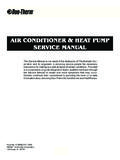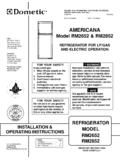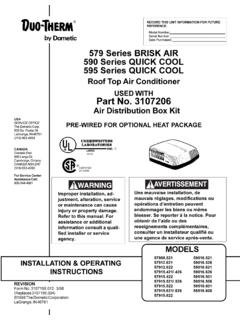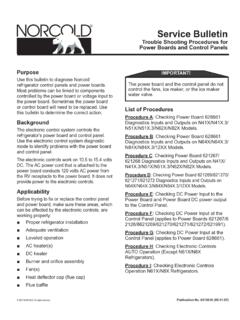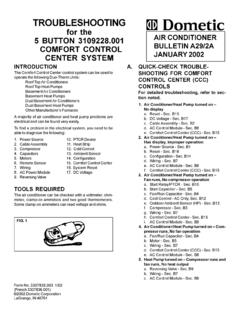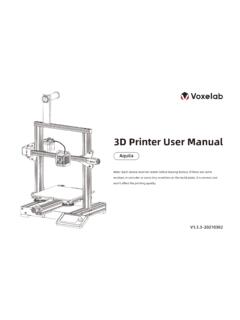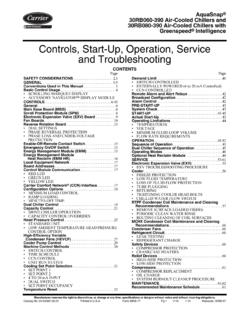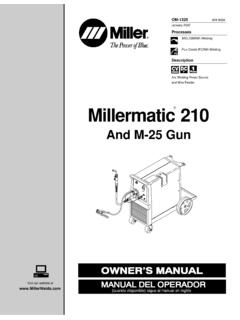Transcription of SERVICE MANUAL FOR 6700, 7000, 8000 & 9000 SERIES AIR ...
1 SERVICE MANUALFOR6700, 7000, 8000 & 9000 SERIESAIR CONDITIONERS(MECHANICAL CONTROLS ONLY)FOR WALL MOUNT THERMOSTATS AND LOW voltage CONTROLCIRCUITS, REFER TO THEIR APPROPRIATE MANUALSFOR ELECTRICAL CHECKOUTS ON DELTA T AND DELTA TXAIR CONDITIONERS, REFER TO MANUAL R-332 (2-86)PREFACEThis SERVICE MANUAL is primarily intended for the use ofqualified individuals specially trained and experienced in theservice of this type of equipment and related and SERVICE personnel are required by some states,counties or cities to be licensed. Persons not qualified shallnot attempt to SERVICE this equipment or interpret this is not a basic refrigeration and air conditioning manualand does not therefore, cover the principles of refrigeration orair conditioning. The user of this MANUAL should havealready accomplished a thorough study of refrigeration andair installation may damage equipment, can createa hazard and will void the use of components not tested in combination withthese units will void the warranty, may make theequipment in violation of state codes, may create a hazardand may ruin the equipment.
2 !WARNING - SHOCK HAZARD!TO PREVENT THE POSSIBILITY OF SEVEREPERSONAL INJURY, DEATH OR EQUIPMENTDAMAGE DUE TO ELECTRICAL SHOCK, ALWAYSBE SURE THE POWER SUPPLY TO THE APPLIANCEIS DISCONNECTED BEFORE DOING ANY WORK ONTHE APPLIANCE. THIS CAN NORMALLY BEACCOMPLISHED BY SWITCHING THE BREAKERFOR THE AIR CONDITIONER TO OFF,DISCONNECTING ALL EXTERNAL ELECTRICALCONNECTIONS AND CORDS, SWITCHING ONBOARD ELECTRICAL GENERATORS ANDINVERTORS TO OFF, AND REMOVING THE CABLEFROM EACH POSITIVE TERMINAL ON ALLSTORAGE AND STARTING DIAGNOSTIC TESTING MAY BE DONE ONENERGIZED CIRCUITS. ELECTRICAL SHOCK CANOCCUR IF NOT TESTED PROPERLY. TESTING TOBE DONE BY QUALIFIED TECHNICIANS TEST DEVICEThis test device is an invaluable aid in quickly diagnosing repairsto all RV Products roof top air conditioners produced after OF CONTENTSB asic Components and Their FunctionsRefrigeration System DiagramI.
3 Refrigeration Circuit .. 5II. Air Handling Circuits ..6 III. Electric Power Circuits .. 6IV. Tools And Equipment .. 10V. SERVICE Problems And Their Solutions .. 13VI. Typical Wiring Diagrams .. 20 QUICK DIAGNOSIS CHARTNote: This charge represents problems with units having mechanical controls - if the air conditioneris equipped with a wall thermostat, please refer to the appropriate CausesRef. Page NumberFan And Compressor Will Not RunNo Power 115V 14 Selector Switch 14 Fan Will Not RunSelector Switch 17 Fan Run Capacitor 17 Motor 17 Wiring (Mis-wired)20-21 Compressor Will Not RunSelector Switch 15 Thermostat 15 Low voltage 15 Overload 15 Compressor 15 Wiring (Mis-wired)20-21 PTCR or Potential Relay16-17 Start Capacitor20-21 Run CapacitorCooling Performance 194 BASIC COMPONENTS AND THEIR FUNCTIONSREFRIGERATION SYSTEM FANFANMOTOREVAPORATORBLOWEREVAPORATORCON DENSER COILHIGH SIDELOW SIDE5 The purpose of this part of the SERVICE MANUAL is to acquaintthe SERVICE Technician with the system components so thatwhen he has a problem, he can intelligently analyze andisolate the problem and efficiently correct COMPONENTS ANDTHEIR FUNCTIONSI.
4 REFRIGERANT ChargeThe systems covered by this SERVICE MANUAL all use arefrigerant called monochlorodifluoromethane (better knownas R-22).We know that R-22 is not a deadly gas because many of ushave breathed it many times and we are still living. But, noone has said that R-22 is completely safe to breathe; so, awise SERVICE technician will always keep a work space wellventilated if R-22 can escape into the air. IF R-22 COMESIN CONTACT WITH ANY OPEN FLAME, PHOSGENEGAS IS CREATED AND ONE SHOULD AVOIDBREATHING THE temperature at which R-22 changes to toxic gases andacids varies with the amount or concentration of waterpresent the greater the concentration of water, the lowerthe temperature and vice versa. high temperatures normallyexist inside a refrigeration circuit, so we must keep the circuitas absolutely dry as possible to prevent the formation ofdestructive R-22 in the atmosphere will always be at about -41.
5 Therefore, always wear safety glasses when working with unburned R-22 is not a deadly gas, so by usingreasonable safety precautions, the SERVICE technician will notbe hurt by addition to being almost non-toxic, R-22 is non-flammable, non-explosive, non-corrosive and miscible(mixable) with oil. It also has a rather high latent heat value. This means that is must absorb a large amount of heat per vaporize or change from a liquid to a vapor; and it mustgive up a large amount of heat per lb. to condense or changefrom a vapor to a and Low SidesIt is customary for air conditioning technicians to use theterms high side and low side. In doing so, we refer to theparts of the refrigeration circuit which, when the system isrunning, contain high pressure refrigerant ( high side) andlow pressure refrigerant (low side).
6 The high side of thesesystems exists from the discharge port of the compressor tothe cap tube. The low side is from the cap tube to thecompressor cylinders. The dividing points then are the captube and compressor high side pressure is also referred to as head pressure orcondensing pressure, and the low side pressure is alsoreferred to as suction pressure or evaporator is impossible to state the exact pressures that will exist inthe high side or low side because those pressures will bothvary with different temperature and humidity conditions bothinside and outside the recreational Tube (Cap Tube)The refrigerant enters the cap tube from the condenser as awarm high pressure liquid. As the refrigerant flows throughthe small diameter cap tube, the pressure drops rather rapidly.
7 As the pressure drops, a tiny amount of the liquid refrigerantwill vaporize. This vaporization requires heat which mustcome from the liquid refrigerant itself - thus the liquidtemperature is constantly lowered as it passes through the captube. As the refrigerant leaves the cap tube, it is still mostlyliquid; however, a small portion has changed to a vaporcalled flash gas. When the liquid refrigerant passes from thecap tube to the evaporator, it is at low side pressure and willtherefore, vaporize at low temperature as it picks up heatfrom the air being CoilThe purpose of the finned evaporator coil is to transfer theheat from the warm and moist indoor air to the cold lowpressure the heat leaves the air, the air temperature drops and someof the moisture in the air condenses from a vapor to a liquid.
8 The liquid water (condensate) is drained onto the roof of therecreational vehicle. As the heat enters the refrigerant in theevaporator, it causes the refrigerant to evaporate (changefrom a liquid to a vapor). Thus the name refrigerant remains at nearly constant temperature(called evaporator temperature or low side saturationtemperature) in the evaporator as long as there are both liquidand vapor together. However, near the outlet of theevaporator coil, all of the liquid has boiled (evaporated) awayand from there on the temperature of the vapor rises (thevapor becomes superheated). It is necessary that the vaporbecome superheated because it passes through the suctionline to the compressor and the compressor can only pumpsuperheated vapor any vapor (which might be present if thevapor were not superheated) could cause serious mechanicaldamage to the LineThe suction line is the tube which carries the superheatedvapor refrigerant from the evaporator to the compressor is called a hermetic compressor which meansthat it is completely sealed (welded together).
9 It is, therefore,not internally field serviceable. Inside the compressorhousing are basically:a)an electric motor which drives the compressor,b)a pump which is designed to pump superheatedvapor only,c)a supply of special refrigeration oil. A small portionof the oil will circulate out through the system withthe refrigerant, but will constantly return to thecompressor with the refrigerant, so the compressorwill not run out of LineThe discharge line carries the refrigerant out of thecompressor and to the condenser coil. Remember that as therefrigerant entered the compressor, it was superheated vapor. The refrigerant enters the compressor, where more heat isadded and is compressed into a smaller space. Therefrigerant, therefore, leaves the compressor highlysuperheated so if the discharge line is hot to the touch(burns), don t be surprised it should Condenser CoilThe purpose of the finned condenser coil is to transfer heatfrom the high pressure refrigerant to the warm outdoor air.
10 As the outdoor air passes over the coil, the heat transfer willcause the air temperature to rise. Thus the condenserdischarge air will be several degrees warmer than thecondenser entering the refrigerant passes through the first few tubes of thecondenser, its temperature will be lowered or it will be de-superheated. After the refrigerant is de-superheated, it willbegin to condense or change from a vapor to a liquid and willremain at a nearly constant temperature throughout almost allof the remainder of the coil. This temperature is called the condensing temperature or high side saturation temperature and will always be higher than the condenser entering the bottom of the condenser, the refrigerant will all becondensed to a liquid and from there on its temperature willdrop to more nearly the temperature of the outdoor air.
